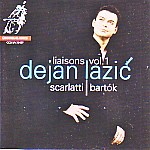Do Scarlatti and Bartók mesh? In theory they might, since each composer’s keyboard miniatures not only draw heavily from folkloric elements but also approach virtuosity from a pedagogical angle. And as it happens, they do sound well programmed back-to-back, at least in this carefully-thought-out program, where Dejan Lazic alternates Scarlatti sonata groupings with equal doses of Bartók. For example, the extroverted repeated-note theme of Scarlatti’s F major K. 82 easily flows into the first of Bartók’s three Rondos on Slovak folk tunes, with its more lyrically shaped repeated-note motive. And who would have thought that Scarlatti’s scampering C major K. 159 could effectively transition into the whimsical first of the Seven Sketches? Notice also how dancing scales provocatively bond Scarlatti’s E major K. 135 and Bartók’s First Dance in Bulgarian Rhythm.
In his booklet notes Lazic admits that going back and forth between Scarlatti and Bartók caused more than a little interpretive cross-pollination. If so, Bartók benefits best. The wealth of color and nuance Lazic brings to lyrical pieces such as the fourth and the last of the Seven Sketches reflects the songful qualities typifying Bartók’s own pianism. Likewise, the Dances in Bulgarian Rhythm do not sacrifice one iota of textural variety to ensure the atomic precision of Lazic’s inner metronome. Furthermore, the pianist’s extraordinary focus and tonal application throughout the Funeral March from Kossuth transcend the music’s orchestral origin.
Regarding the Scarlatti selections, Lazic’s exaggerated staccatos and short, angular phrasings seem less like Bartókian spillover and more like the pianist reverting to that picky, mannered playing style he previously employed on disc to distort Ravel and Chopin (see my comments by typing Q2998 and Q5202in Search Reviews). A couple of examples will suffice: Lazic’s seasickness-inducing tempo fluctuations in the E major K. 380 sonata make Ivo Pogorelich’s effects-mongering seem saintly by comparison; and the F major K. 17’s metric nudges and shoves run the music into the ground rather than propel it forward. However, when Lazic chooses to keep the pulse relatively steady, his brash technical prowess gains characterful dividends, such as in the F major K. 82’s arrogantly even trills. Whether in surround-sound or conventional two-channel mode, Channel Classics’ clear and full-bodied engineering is state-of-the-art.
































